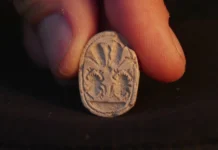This Parasha followed the sin of the Golden-Calf. HaShem commanded Moshe to count the “Heads” of Bnei-Yisrael, “רֹאשׁ בְּנֵי-יִשְׂרָאֵל”, by way of giving a half Shekel as a Terumah. This comes to teach us that the heads of the nations are the ones who will be responsible for their people. We notice here that HaShem spoke only of Bnei-Yisrael and not the ‘Erev Rav” (the Egyptians converts) who joined the people of Israel after the ten plagues. We see in the Torah that HaShem refers to the Erev-Rav (“ערב רב”) in two terms, “Amecha” “עמך“ (your people speaking to Moshe following the Golden Calf sin) and “Am” (“עם“ – just a nation). To the people of Israel, however, HaShem refers to as Bnei-Yisrael (the sons of Israel/Yaakov) and “Ami” (עמי“ – My nation). From here we learn that the Erev-Rav, the converts, were the ones that started the sin. The words “Ki Tisa” (“כִּי תִשָּׂא”) also comes to teach us that by counting Bnei-Yisrael, HaShem will provide blessings and save many of them due to the giving of Terumah as it is known as “Kofer Nafsho” (“כֹּפֶר נַפְשׁוֹ” – ransom for their soul). It is interesting to point out that the numerical value of the word “Shekel” (“שֶׁקֶל“) is 430, same as the numerical value of the word “Nefesh” (“נַפְשׁ“), and same as the number of years of the exile, as promised to Avraham.
We know that righteous leaders are ready to “sacrifice” themselves in order to save the entire Bnei-Yisrael, as Moshe did several times when Bnei-Yisrael sinned. HaShem counted Bnei-Yisrael after every time a severe punishment was brought upon them, but he also blessed them at the same time. HaShem is like a shepherd whose flock was attacked by a pack of wolfs, and after the attack he counts them and brings them closer to Him with love and extra care. This amazing way of counting provides the people of Israel much needed blessings and elevation. The word “Tisa” (“תשא”) means to lift up. We see here a beautiful way of taking an earthly material, the silver, and using fire, a heavenly light, to create a coin. HaShem ordered Moshe not to count them by numbers rather by giving a half Shekel; the Midrash tells us that evil-eye has power over numbers. We know that when King David counted Bnei-Yisrael (by numbers) without HaShem’s permission, many of them died. The Half-Shekel equaled twenty “Gerah” to teach us that we are only obligated to give twenty percent of our money to Tzedakah.
We can count our people for a Minyan (10) in ways of blessings, using common blessing such as the blessing on bread, “Hamotzi Lechem” (“המוציא לחם מן הארץ”), as it has ten words in it. The reason such blessing has the number ten in it is also to teach us of the tenth “Ma’aser” we give as Terumah. There are many other blessings containing ten words to help us count without using numbers. It is worth noting here that in this Parasha the Aliyah of the Kohen and the Aliyah of the Levi are the longest readings in the Torah; almost half of the entire Parasha is given to them. The reason for that is because the tribe of Levi did not take part in the Golden-Calf sin. Now and then, they atone for the entire Bnei-Yisrael, by not embarrassing them with an Aliyah for this Torah reading, as the story of the Golden-Calf appears within the first two Aliyot.
HaShem showed Moshe how to make the silver coin, just as He showed him the final product of the Menorah. The reason Bnei-Yisrael were ordered to give only half a Shekel, is to teach us that we are not fully complete (whole) without HaShem and the Torah. We also learn from the half a Shekel the way of learning Torah; always learn with someone else (Chavrutah) as they can complete our understanding as a Rabbi and a “Chaver” (“חבר” – friend). The word “Chaver” (“חבר”) has the word “Rav” (“רב” – Rabbi) and “Bachar” (“בחר” – choose), to teach us that we shall choose our friends carefully as we can learn from them, same as from a Rabbi. The half a Shekel also represents our purpose in life of marriage as our other half makes us whole. We see that even HaShem made the Ten Commandments on two halves. We also learn that when we are counted together HaShem has mercy on us as a whole rather than as individuals.
Our sages taught us in Pirkai Avot a profound lesson “make (choose for) yourself a Rabbi, and buy yourself a friend” (“יְהוֹשֻׁעַ בֶּן פְּרַחְיָה אוֹמֵר, עֲשֵׂה לְךָ רַב, וּקְנֵה לְךָ חָבֵר, וֶהוֵי דָן אֶת כָּל הָאָדָם לְכַּף”), alluding to making careful choices. Rabbi Yehuda Hadjadjh teaches that the teaching of “buy yourself a friend” (“קנה לך חבר”) does not really mean to “buy” as the word “Kene” could be understood. The word “Kene” (“קנה”) can also mean “Kene-Suf” (“קנה סוף” – bamboo), which is used by the Sofer Stam (a scribe who writes Torah, Tefillin and Mezuzut) to ink the words on the parchment. He explains that while doing business with friends one should write all agreements and understandings and “ink it” with “Kene-Suf” as it would help maintain true friendship and avoid Machlokot (“מחלוקות” – disagreements). True friends are those who act according to Torah laws.
The counting of Bnei-Yisrael was meant to provide an accurate head-count of every male over the age of twenty (also for military use) and up to the age of fifty. By showing Moshe how to make the Half-Shekel HaShem reminded Bnei-Yisrael of the Golden-Calf sin. HaShem allowed them the use of this donation to build the Mishkan and do Teshuvah. This offered all of Bnei-Yisrael an equal opportunity to participate in the Mitzvah of building of such a holy sanctuary for them and for HaShem, regardless of one’s wealth. The Torah writes about such equality “the rich shall not give more, and the poor shall not give less“ (“הֶעָשִׁיר לֹא-יַרְבֶּה, וְהַדַּל לֹא יַמְעִיט”). When the people of Israel are united HaShem rewards us, but when we are not united we are punished. Just as the process of mixing fire (Divine power) and silver (earthly and non-holy material) we create the coin, so too when we are separated from HaShem and from each other, HaShem sends fire (war) to unite us. We saw examples to that in the time of Amalek, Haman, Caesar, and Hitler, to name a few (may their memory and offspring will be removed, erased and obliterated forever). Only when we all understand that we are half and must have the other half as HaShem, we are one.
Our Sages say that when HaShem ordered for the specific Half-Shekel donation, He gave (33: 15) definitive instructions: “the rich shall not give more, and the poor shall not give less“ (“הֶעָשִׁיר לֹא-יַרְבֶּה, וְהַדַּל לֹא יַמְעִיט”). The “Rich” is a man who knows lots of Torah, and the “Poor” is one who knows less. HaShem was also telling the people of Israel, not to be proud, or to “show-off”, even when one feels “rich” in Torah. To the “poor” one, HaShem says do not stop or lessen yourself, try and I, HaShem, will help you, as we say in our daily prayers “humiliating proud Adei Earth (to the bottom), raising humbles to the highest levels“ (“משפיל גאים, עדי ארץ. מגביה שפלים עד מרום”). HaShem despises proud people who use their Torah knowledge for the wrong reasons. Our Sages explain that even a Torah scholar who does not have manners is considered as a “dead animal in the marketplace, as it says in Midrash VaYikra Raba: “ כל תלמיד חכם שאין בו דעת, נבלה טובה הימנו ”.
We learn that in the time of king Achashverosh in Persia, the people of Israel were not united and Haman saw an opportunity to try and eliminate them. He approached the king with the notion that the Jews are not united under HaShem’s laws, and offered to kill them all. Only by HaShem’s mercy and Divine Hashgacha (interference) through Mordechai and Ester (מורדכי ואסתר) did we see the reversal of such a decree. Eshter understood that only when the Jews are united, they will merit HaShem’s help. She ordered all the Jews to unite and pray to HaShem. Haman, a descendant of Amalek, is the “Fire” HaShem sent in order to teach Bnei-Yisrael a lesson. Esther is just like the “Silver” coin (the Half-Shekel) who, together with the “fire” (HaShem), united the Jews and removed the bad decree. It is important to mention here that in the name Esther we find the word “Seter” (“סתר“) which means hidden/secret. Esther’s real name was Hadassah (“הדסה“) and this name has the word “Sod” (“סוד“), secret in it. Esther was an orphan and Mordechai’s second cousin and wife. Haman was a barber and Mordechai helped him with a loan, prior to him becoming second to the king Achashverosh.
HaShem promises that when we give we are guaranteed that our soul will be redeemed and our body would not suffer illness. By giving (what was given to us) we are provided with many Mitzvot, such as the Mitzvah of Minyan, the ten people needed for certain prayers in synagogues such as the Kaddish, just as with the Ten Commandments – on one side are the five laws between HaShem and men and on the other side are the five laws between men to men, and together we have a complete Minyan. Only with a Minyan we can offer more blessings and do more Mitzvot.
The word “MaChatzit” (“מחצית“ – half) has a hidden message in it, as there are two words in it: “Half” (“חצי“) and “Death” (“מת”). it teaches us that when we do not give the Half-Shekel we will most likely be considered dead, and when we do give we are saved. By giving half-shekel we keep the letters of the word “Met” (dead) “מ-חצי-ת” apart by the word “chetzi” (“חצי“ – half). This shows the importance of giving to help build a Mishkan, a Synagogue, a Yeshivah and, of course, the Beit-HaMikdash. By giving, we are guaranteed long life and prosperity, just as the Torah says: “Tzedaka Tatzil Mi Mavet” (“צדקה תציל ממוות”). Donating will save one from death, as it is considered as atonement. We see that HaShem uses the term “Kippurim” to teach us that we all can do Teshuvah regardless of the magnitude of the sin (such as the golden-calf). These donations allowed everyone to participate in communal sacrifices in the Mishkan, as these Korbanot atoned for their sins. The Ramch”al says that without HaShem’s attribute of mercy, we would have been punished instantly, without the option to repent and do Teshuvah.


























